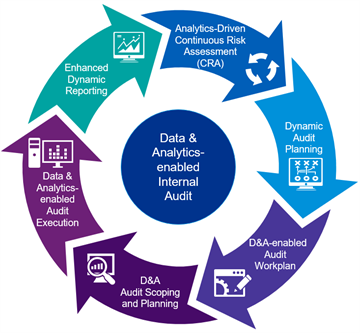Data & Analytics in the Government Finance Function
Data and analytics (D&A) is a hot topic in both government and private sector finance. This blog focuses on D&A in governmental internal audit and compliance monitoring, but many of the observations are applicable to other functions.
By Gregory Frank, CPA, advisory manager, data & analytics, KPMG LLP and Joseph E. Seibert, CPA, CGFM, partner, KPMG LLP
Data and analytics (D&A) is a hot topic in both government and private sector finance. With government in particular, there are many applications where D&A can increase effectiveness: in the controller’s office, budget office, and procurement office, or through the external audit, the internal audit, and the compliance monitoring functions.
This blog post focuses on D&A in the internal audit and compliance monitoring functions, but many of the observations are applicable to other functions.
Elevating Internal Audit and Compliance Monitoring
At the most basic level, D&A can be integrated within traditional audit execution processes to identify key risk and performance metrics that can enhance audit sample selection. Internal audit departments that are further along the maturity curve may use D&A as part of the prefieldwork scoping and audit planning, which can help build the foundation for continuous auditing capabilities.
Implemented in these areas, D&A can help internal audit departments simplify and improve the audit process while providing a higher quality audit. Benefits could include increased operational efficiencies; reduced costs; more timely detection of errors, waste, and abuse; and new insights into potential performance opportunities.

Source: KPMG
As D&A evolves, organizations will be able to review every transaction – not just a sample – on a regular basis, which drives more efficient analysis of financial information on a grander scale. What’s more, it helps organizations automate certain activities and implement continuous risk assessment and continuous auditing, which drives greater effectiveness, increased coverage, and greater efficiency.
Greater Effectiveness:
- Focus effort on greatest impact areas
- 100 percent testing to identify business rule exceptions and to evaluate outliers
- Investigate scenarios with transaction combinations that create risk exposure
- Identify areas for improvement that may reduce costs or increase revenues
Increased Coverage:
- Expand audit breadth and risk coverage by leveraging analysis results for process assessment and risk-trigger identification
- Increase the frequency of audits with improved efficiencies and repeatability
- Create operations transparency and business partnering opportunity for continuous auditing and continuous monitoring
Greater Efficiency:
- Audit evidence from source data prepared by and for audit purposes
- Automated and repeatable audit testing
- Independently obtained data and evidence via integrated data acquisition tools
- Dynamic reporting and visualization
To hear more about data and analytics in the government finance function, attend the Government Accounting Conference on July 10-11 in Hershey or via webcast. View the agenda and register at www.picpa.org/govtacct.
PICPA Staff Contributors
Disclaimer
Statements of fact and opinion are the authors’ responsibility alone and do not imply an opinion on the part of PICPA officers or members. The information contained in herein does not constitute accounting, legal, or professional advice. For professional advice, please engage or consult a qualified professional.






